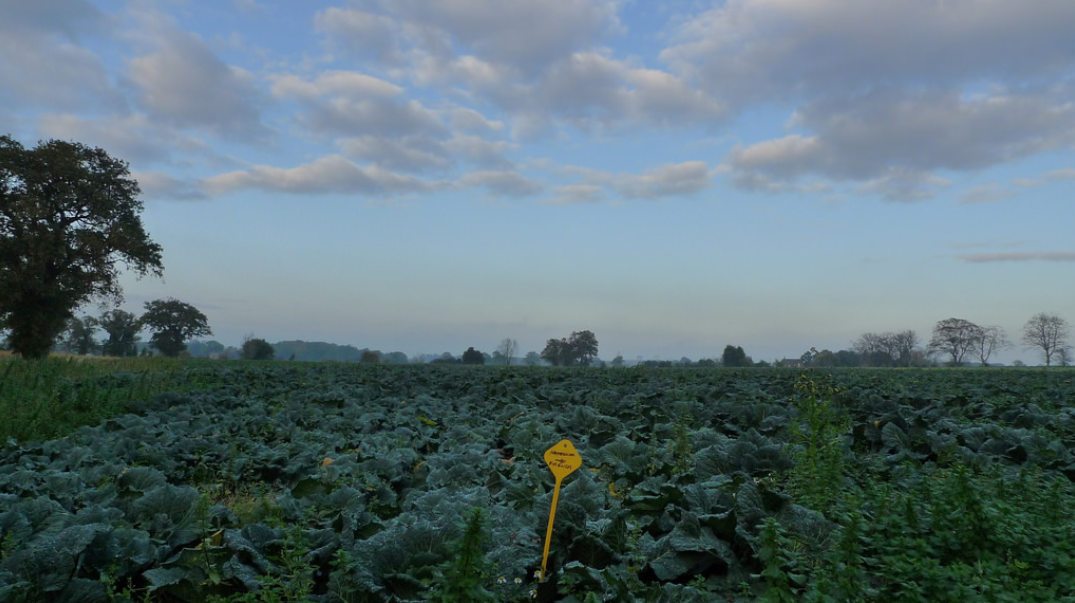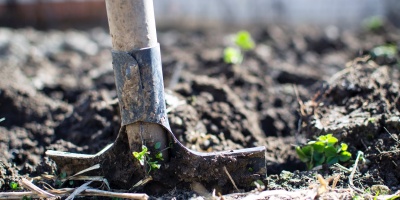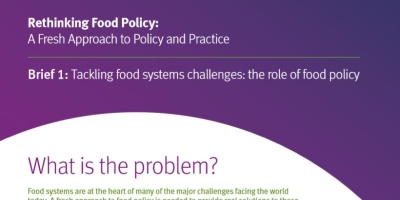
Image credit: Nick Saltmarsh Savoy field with signpost, Flickr creative commons licence
The organic industry has vocally rejected genetically-modified crops (GMOs), making a public declaration in 1993 that they are incompatible with organic agriculture. Since then, many organic supporters have campaigned against GMOs, and organic farming regulations in the EU and beyond prohibit their use. Emerging genetic technologies have sparked renewed interest in this debate, but policy makers are still undecided on whether they should be subject to the same extensive regulations as genetic modification. Within the organic industry, there are different perspectives on whether these new techniques could ever be compatible with organic food production. In this blog-post Rebecca Nesbit gives us an insight into these differing perspectives, interviewing proponents from each side.
Strict standards define which agricultural practices can be used by organic farmers. These don't allow any synthetic pesticides or herbicides, and place an emphasis on protecting wildlife and promoting animal welfare. They also cover which techniques breeders can use to produce organic seeds.
Over the last few years, new tools have rapidly created possibilities in plant breeding. These New Plant Breeding Techniques (NPBTs) have been met with both excitement and concern. They are blurring the line between conventional breeding (which can involve inducing random mutations into a plant’s DNA) and genetic modification, which introduces entire genes.
NPBTs are a collection of tools which can be used to modify a plant’s DNA, the most famous being CRISPR-Cas9, which was the topic of a blog-post[1] by FCRN associate Jessica Finch earlier this year. The changes can be very small (altering just a few individual DNA bases) or more extensive. Entire genes can be inserted into the crop’s genome, whether these are from another variety of the same crop or from a different species entirely. These genes can be inserted into a known location, unlike those introduced with older genetic-modification techniques. This reduces the risk of unintended consequences which are often highlighted as an objection to GMOs.

In conventional agriculture, policy makers in many parts of the world are still trying to work out which NPBTs, if any, should be subject to the same regulations as GMOs. The USA has deemed that crops made using NPBTs should not be regulated as GMOs, while the EU remains undecided. As noted in the FCRN blog-post [2] mentioned above, in November 2015 Sweden became the first EU country to deliver a legislative ruling on whether plants developed using CRISPR-Cas9 should be regulated as GMOs. The Swedish Board of Agriculture ruled that some plants edited using CRISPR-Cas9 technology fall within the GMO definition whilst others do not. The distinction is based on the presence or absence of foreign DNA: plants with foreign DNA introduced were ruled to be GMOs, while edited plants lacking foreign DNA were ruled not to be.
Whilst some organic farmers are calling for NPBTs to be permitted in organic agriculture, certification bodies are making their position clear: crops made through NPBTs are incompatible with the organic ethos.
In February 2017, the International Federation of Organic Agriculture Movements (IFOAM) released a draft position statement [3] on breeding techniques in organic systems, which concludes that ‘organic breeding refrains from breeding techniques that interfere directly at DNA level’.
Not only does this rule out NPBTs, but even a common technique in conventional plant breeding: mutagenesis[4] .This uses chemicals or radiation to create random mutations in a plant’s DNA, giving breeders more variation to work with. Under the IFOAM guidelines, mutagenesis is not allowed for organic breeding. However, IFOAM’s position statement recognises that a lack of labelling means it can be impossible to tell whether a variety used in organic agriculture has been created using mutagenesis.
The strict stance on mutagenesis isn’t upheld in all countries. Mutagenesis breeding is permitted by the National Organic Program[5] in the USA, although elsewhere there is often a lack of clarity in organic standards.

Image credit: Squirrel Nation, Flickr, Creative commons licence
Without access to the tools used by breeders in conventional agriculture, can organic breeders meet the industry’s needs? A principle of organic farming is to adapt the seed to the environment, not the environment to the seed, yet organic agriculture suffers from a lack of crop varieties suited to their growing conditions. Conventional crop varieties have often been developed for high-input systems, whereas organic farming needs crops which can thrive without synthetic fertilisers and chemicals. Some characteristics which are favourable on conventional farms can even negative side-effects[6] in organic systems. Modern cereal crops, for example, may have decreased disease resistance.
Some people have therefore argued[7] that organic agriculture should embrace NPBTs to produce seeds which are ideally suited to its growing conditions.
To get a better understanding of the different perspectives on the use of NPBTs within an organic production system, as well as where the dividing lines in this debate are currently found, I asked two experts for their views on whether genetic techniques could or should be accepted within the organic production model?
Raoul Adamchak – Organic Farmer
 Raoul has been farming organically for 30 years, and is the co-author of “Tomorrow’s Table[8] : Organic Farming, Genetics, and the Future of Food”.
Raoul has been farming organically for 30 years, and is the co-author of “Tomorrow’s Table[8] : Organic Farming, Genetics, and the Future of Food”.
Question: What do you think New Plant Breeding Techniques could bring to organic agriculture?
Answer: This is a difficult question to answer. CRISPR’s capability to improve plants is similar to mutation breeding. Since mutationally-bred plants are permitted by the US National Organic Program[9] , there is the possibility that this use of CRISPR could be allowed in organic agriculture.
However, CRISPR can also be used to insert new genes into plants, as is done by genetic engineering. The only advantage to using CRISPR is that the new gene can be placed in a precise location in the genome. This latter function is likely to be regulated with as much rigour as genetic engineering and probably viewed negatively by the organic community. So, I think, it is only the deletion and editing functions of CRISPR that are worth addressing with regards to the National Organic Standards. Then, the question becomes, what organic crop production problems could be solved using deletion or editing? To figure that out, it is necessary to know which gene is causing a specific problem. If that is already known, then probably plant breeders have tried to use traditional breeding methods to select for plants without that gene. Only if they have failed could the problem potentially be solved using CRISPR. If the specific gene causing the problem is not known, it can take years of research to identify it.
We know of one gene deletion which has been effective in improving a crop – one of the first genetically-engineered traits to be applied (remember the Flavr Savr[10] ?) was the deletion of a gene that causes softening in tomato fruits. Breeders could use CRISPR to knock out this gene in heirloom tomatoes, and they would soften less rapidly. This could be of benefit to organic growers.
Question: What would it take for them to be accepted?
Answer: To be accepted by the organic community, using CRISPR would have to be seen as being a better method of crop improvement than mutational breeding, and of course it is. It is more precise than mutagenesis and avoids unwanted mutations, opening up possibilities for crops which couldn’t be developed using older techniques[11] . As long as mutational breeding is accepted by the National Organic Program, then this type of CRISPR function should be accepted as well.
Question: Do you think that we can close the yield gap between organic and conventional agriculture without using NPBTs?
Answer: There are many different reasons for a yield gap[12] between organically and conventionally grown crops. Some have to do with lower pest-related (insects, diseases, weeds, nematodes) losses of conventional crops and some have to do with higher levels of nitrogen[13] used on conventionally grown crops. CRISPR can potentially address a few of the pest loss problems as researchers have used CRISPR to knock out genes that serves as binding sites for invading pathogens, giving the plants resistance[14] . However, I don’t see how nutrient related issues in organic could be solved using CRISPR. Researchers are working on increasing nitrogen use efficiency using genetic engineering practices. However, it is unlikely that is something that could be done using gene editing. It is probably a multi-gene trait, that requires genes from other species… if it can be done at all.
Question: Is organic farming being held back by a lack of suitable crop varieties? Do you have an example?
Answer: Organic farmers have access to a wide range of varieties, and are only excluded from using a few genetically-engineered varieties of crops such as corn, soybeans and alfalfa, sugar beets, papaya, summer squash, potatoes, and apples, and a few varieties of crops that may only be available as seed treated with fungicides. Look at any seed catalog from companies that cater to organic growers – Johnny’s, Territorial, High Mowing – and there are plenty of varieties of veggies from which to choose. Organic growers can use un-treated, conventionally grown seed, which means there are still a lot of options.
There is debate on whether crops bred under conventional farming conditions are well adapted to organic conditions[15] , and there are groups such as the Organic Seed Alliance [16] that promote plant breeding under organic conditions to develop varieties better suited to organic farming. As a grower of vegetables, I have never felt there was a lack of good varieties available to me. I have read that organic field corn growers would like more effort put into non-GE varieties, since the major seed companies have focused on corn with GE traits.
I think the bigger question is about producing crop varieties to withstand difficult problems such as banana wilt or severe climatic changes that lead to droughts or flooding. Can organic and conventional growers continue to produce abundant crops without using CRISPR or genetic engineering and genetic engineering to help solve the most serious food production challenges?
Honor Eldridge – Policy Officer, Soil Association
Honor is currently in the Policy team at the Soil Association, the largest organic certification body in the UK. Her focuses include global development agriculture, immigration in the farming sector, trade policy and technological innovation.
Previously, she was the Legislative and Government Affairs Coordinator in Washington D.C. for the Center For Food Safety, a non-profit organization that focuses on food safety, genetic engineering, and agroecological/organic farming.
Question: What is the current situation with the use of mutagenesis breeding in organic agriculture?
Answer: The Soil Association is unaware of any seed companies who are currently using mutagenesis breeding techniques to produce organic seed or to develop new varieties. The Soil Association standards do not ban mutagenesis-bred seeds.
However, mutagenesis breeding is not the same as gene-editing technologies, which are banned from organic agriculture, just as genetic modification is banned. The position of the organic movement is clear: all new genetic engineering techniques should be, without question, considered as techniques of genetic modification and all resulting products should be considered to be GMOs.
Question: Why are New Plant Breeding Techniques banned in organic agriculture?
Answer: The Soil Association’s position is that genome editing techniques are not compatible with the ideology of organic agriculture. Organic agriculture is based on the four principles of ecology, health, fairness and care. It focuses on promoting biodiversity, soil quality, closed production cycles and enhancing ecological processes based on care and respect of the health principle. It is a systemic and process-oriented approach that acknowledges the importance of the precautionary principle. In line with our philosophy, the organic movement opposes the cultivation and release of GMOs into the environment and to their use in agriculture.
New gene-editing technologies may create unintended effects that are damaging to the environment or that pose a risk to human health. Just as with other GM techniques, CRISPR technology is capable of disrupting the genome in ways that could lead to unpredictable side effects, which could have negative and irreversible environmental or other impacts. As with other GMOs, once released into the environment, it may be impossible to remove them should problems occur.
Question: Is there a situation where some form of genetic manipulation would be allowed?
Answer: No form of genetic-engineering or gene-editing would be permitted within organic agriculture. Along with other NGOs and some EU governments, IFOAM EU considers that all GM techniques fall under the scope of the EU’s GMO legislation.
The organic movement allows for the traditional breeding of varieties to foster the development of suitable and efficient varieties that are GMO-free and patent-free. We encourage the cultivation of hybrid seed[17] to develop specific phenotypic traits that are deemed more desirable, which can help farmers adapt to a changing climate by breeding all sorts of drought and pest tolerant plants. For the Soil Association, the “hybridisation” technique is the deliberate crossing of two different parent varieties from the same species to offer greater disease resistance, vigour and uniformity than open-pollinated or heirloom varieties. Hybrid cultivars are fertile but tend to produce inconsistency in the next generation, which is why producers tend to purchase new seeds. A hybrid can be produced organically and many have been. The term does not mean that the seeds have been genetically modified at a cellular level.
This type of plant breeding tends to be low-cost, low-tech, and delivers practical results faster than GM techniques. That said, new technological developments (such as Marker Assisted Selection[18] ) are making these processes more effective and exact.
Question: Does organic agriculture have the tools to create the seeds it requires to be productive and sustainable?
Answer: Yes. Organic agriculture is best placed to help farmers be produce food while protecting the environment. According to the UN’s Food and Agriculture Organization, the global soil has just sixty harvests left, largely as a result of years of chemical exploitation, and it is vital that we look to sustainable farming methods and adopt more regenerative agricultural practices.
Organic agriculture has been shown to deliver a range of essential benefits. Several studies have found that organic systems perform better than non-organic in years of water stress, with one study indicating that organic systems out-produce non-organic by 70-90% during extreme droughts. Healthier soils in organic systems significantly increase the water-holding capacity of soils – up to 100% in one study. This can help to guard against the impacts of both droughts and floods, and mitigate against potential water scarcity and competition from other sectors.
Organic crops are also generally found to be less susceptible to pest pressure than non-organic. This could be for a number of reasons: greater soil microbial biomass, slower growing and more robust plants or the increased presence and diversity of predatory insect and bird species. Organic farmers usually grow a greater number of crop varieties, more suited to local conditions, and typically operate more mixed farming systems (where farmers grow crops and livestock together). This diversity helps to secure a more resilient food supply and income for the farmers themselves.
The FCRN would love to hear your thoughts about this topic in the comment section below. We are also interested in expanding this discussion on GMOs and organic farming, especially given the last comment by Raoul in the interview above. What will climate change mean for the future of agriculture, and will even be possible to maintain the types of agricultural production we have today in the future? Will both conventional and organic production need to reconsider methods and principles? If you are interested in giving us your thoughts about this in a follow up post, get in touch with Tara Garnett (taragarnett@fcrn.org.uk)
[1]http://www.fcrn.org.uk/fcrn-blogs/jessica-finch/genome-editing-techniqu…
[2]http://www.fcrn.org.uk/fcrn-blogs/jessica-finch/genome-editing-techniqu…
[3]https://www.ifoam.bio/en/news/2017/02/02/consultation-breeding-techniqu…
[4]http://www-naweb.iaea.org/nafa/pbg/mutation-breeding.html.
[5]https://www.ams.usda.gov/about-ams/programs-offices/national-organic-pr…
[6]http://www.sciencedirect.com/science/article/pii/S157352141000014X
[7]http://www.mdpi.com/2071-1050/9/3/392
[8]https://global.oup.com/academic/product/tomorrows-table-9780199342082?l…
[9]https://www.ams.usda.gov/about-ams/programs-offices/national-organic-pr…
[10]https://gmfromthefence.wordpress.com/2017/10/27/flavr-savr-that-isnt-fi…
[11]http://www.sciencedirect.com/science/article/pii/S0734975014001931
[12]http://journals.plos.org/plosone/article?id=10.1371/journal.pone.0161673
[13]http://www.sciencedirect.com/science/article/pii/S0308521X1100182X
[14] https://www.ncbi.nlm.nih.gov/pmc/articles/PMC5099147/
Or https://www.ncbi.nlm.nih.gov/pmc/articles/PMC5253358/
[15]http://www.sciencedirect.com/science/article/pii/S157352141000014X
[17]https://www.rhs.org.uk/advice/profile?PID=710
[18]http://www.isaaa.org/resources/publications/pocketk/19/default.as






Post a new comment »